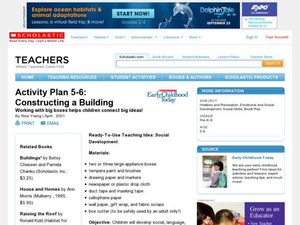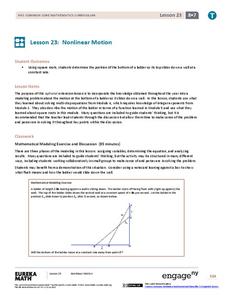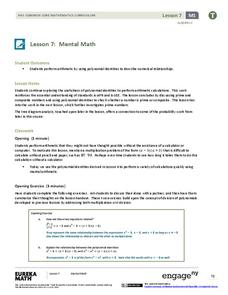EngageNY
Determining Discrete Probability Distributions 1
Learn how to determine a probability distribution. In the ninth installment of a 21-part module, future mathematicians use theoretical probabilities to develop probability distributions for a random variable. They then use these...
EngageNY
Read Expressions in Which Letters Stand for Numbers II
Reading and writing take on a whole different meaning in math class. Young mathematicians learn to read verbal phrases by focusing on operation words. They write equivalent algebraic expressions for both mathematical and contextual...
National Security Agency
Place Value - Butterflies Floating Place to Place
Learn about butterflies and place value in a series of interdisciplinary lessons! With several worksheets that reference butterfly facts in word problems, kids can practice science and math in one activity. Additional worksheets are...
Illustrative Mathematics
Currency Exchange
Take your class on a North American adventure with a currency conversion problem. Pupils are asked to change US dollars into Canadian dollars and then to Mexican pesos. The commentary includes two solutions, converting by unit rates and...
Curated OER
"Weighing the Elephant"
Can your class solve the problem presented in the Chinese folktale, "Weighing the Elephant?" Read your class the description before having them attempt to solve the problem. After they've come up with an answer (or attempted to!), finish...
Creative Visions Foundation
Introduction to Pre-production: Developing Ideas
Continue with creating documentaries with the fourth lesson in a series. After explaining the concept of preproduction, send groups off to make some decisions about their films. Groups can use the handout and the four provided questions...
Curated OER
Science Journal Writing: Observation, Problem Solving
Students consider the value of keeping a science journal. They make a journal and prepare the first entries.
Curated OER
Use of Literature in SDMPS
Young scholars demonstrate their knowledge of the eight step problem solving process. They describe how the story would change according to the solution chosen, then rewrite an ending to the story based upon a solution other than the one...
Curated OER
The 400 Problem
Students develop the skills of problem solving and logical analysis. The conditions of when two subtraction sums are equal is examined to develop other skills like practicing arithmetic in context.
Curated OER
Solving the following Cryptarithm
In this algebra worksheet, students solve a cryptarithm by deciphering a word problem and finding out how many potential solutions the puzzle has. There is 1 question with an answer key. This would be a great Algebra warm up problem.
iCivics
Step Eight: Positions, Please!
Everyone sees the results of public policy, but not everyone understands the strategy that goes into creating an effective one. Now that your class understands the brainstorming process from earlier in the series, they continue on to the...
Curated OER
Think Fast! What Would You Do If . . .
Fifth graders use critical thinking and problem solving skills. It allows students to make choices and to use imagination to develop a solution for each problem. Solutions are then presented to the class.
Curated OER
Simple Machines and Modern Day Engineering Analogies
Learners apply the mechanical advantages and problem-solving capabilities of six types of simple machines (wedge, wheel and axle, lever, inclined plane, screw, pulley) as they discuss modern structures in the spirit of the engineers and...
Curated OER
Constructing a Building
Students work with big boxes to connect big ideas. In this early childhood problem solving lesson, students develop social, language, math, creative-thinking, and problem-solving skills as they work together to plan and design a...
Curated OER
Artificial Limbs & Robotics
Students design and build a mechanism to retrieve wrapped candy through a small hole (e.g. through the top of a water cooler jug). They gain an appreciation for the challenges faced by people who have lost the use of their limbs. They ...
Curated OER
One + One=One
Students discover that learning can be fun. Problem solving skills are developed through various writing skills. Empower students with personal concept development and time management. Document growth and success of the learner....
Curated OER
Crayon Resist
Kids usually love crayon resist projects. It is so fascinating for them to see how the dark paint accentuates and resists the waxy crayon. Here are instructions for executing a crayon resist project of your own. Tip: Make the project fit...
Curated OER
Fill a Jar
Sometimes short lesson outlines are enough to give you a great idea. Young writers draw any object inside an image of a jar, that doesn't belong in a jar. They can draw a tree, truck, or dinosaur. Tip: Have kids write a short story...
EngageNY
Nonlinear Motion
Investigate nonlinear motion through an analysis using the Pythagorean Theorem. Pupils combine their algebraic and geometric skills in the 24th lesson of this 25-part module. Using the Pythagorean Theorem, scholars collect data on the...
EngageNY
Converse of the Pythagorean Theorem
Discover a new application of the Pythagorean Theorem. Learners prove and apply the converse of the Pythagorean Theorem in the 17th lesson in a 25-part series. The examples ask learners to verify right triangles using the converse of the...
EngageNY
Mental Math
Faster than a speedy calculator! Show your classes how to use polynomial identities to multiply numbers quickly using mental math.
EngageNY
Recursive Challenge Problem—The Double and Add 5 Game
Math is all fun and games! Use a game strategy to introduce the concept of sequences and their recursive formulas. The activity emphasizes notation and vocabulary.
EngageNY
Efficacy of Scientific Notation
How many times could California fit into the entire United States? Pupils use scientific notation to find the answer to that question in the 12th installment of 15 lessons. It asks scholars to write numbers in scientific notation and...
EngageNY
Modeling Riverbeds with Polynomials (part 1)
Many things in life take the shape of a polynomial curve. Learners design a polynomial function to model a riverbed. Using different strategies, they find the flow rate through the river.

























